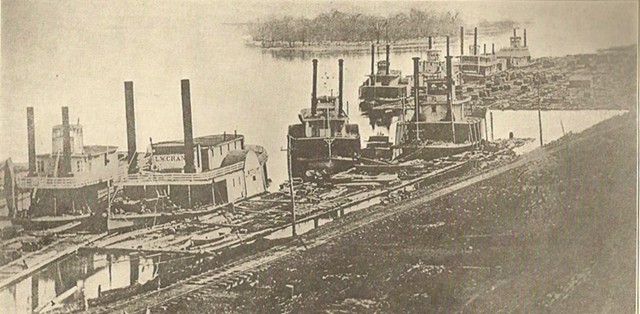THE LARGEST RAFTS
203
The largest raft brought down the river during the fifty years from 1865,
when they first began using steamer to tow the raft until the
steamer 'Ottumwa Belle' ran the last raft 1915, was taken from Stillwater
on Lake Saint Croix to Saint Louis by Captain George Winans with the
steamer 'Saturn.'
This raft was sixteen strings wide and forty-four cribs long, rafted
twenty-six courses deep.
It was two hundred and seventy feet wide by fourteen and fifty feet
long and with the top load contained nine million feet of timber.
The 'Saturn ll' was a good, strong boat with engines sixteen inches by
five foot and Captain Winans had a good bow-boat on the head. This trip was
made in 1901.
The largest log raft was brought from Lynxville to Rock Island in 1896 by
O.E. McGinley with the steamer 'F.C.A. Denkman,' using the 'H.C. Brockman' as
her bowboat. The raft was two hundred and seventy feet wide and fifteen
hundred and fifty feet long, containing about two and one-
quarter million feet.
Some double-decked or double-tiered log rafts were brought from Stillwater
in the nineties. When they were careful to place only small log on top,
crosswise, they did fairly well in good river, but when they were careless
and hauled large logs up on top and loaded unevenly, these rafts soon
encountered trouble when they struck shallow water. Double-deckers were never
popular with the pilots who had to run them or the crew that
had to work on and over them.
204
The Last Raft - The End of the Game
The first rafts run from 1838 to 1843 were lumber from the Wisconsin river
and from Saint Croix Falls.
The last raft brought down the Mississippi was also lumber sawed and
rafted at Hudson, Wisconsin, on Lake saint Croix. I was in eight strings,
thirty-six cribs long and rafted twenty-eight courses deep. They made a raft
one hundred and twenty-eight feet wide and eleven hundred and fifty
feet long, which contained three and one-half million feet of lumber and it
carried about a million feet of top load consisting of, timbers, lumber and
lath.
This raft was towed by the steamer 'Ottumwa Belle' with the 'Pathfinder'
as a bowboat. The little steamer ' J.M.,' that had been engaged in towing
logs from Saint Paul boom to Prescott was hitched in alongside the raft near
the bow and taken down river to be sold.
Captain W.L. Hunter of Wynona was in charge as master and pilot and
made a nice, clean trip from Hudson to S. & J.C. Atlee at Fort Madison
in fourteen days with a single crew.
Captain Hunter had been on the 'Ottumwa Belle' doing Atlee's running
until the logs gave out, but in `1915 was piloting on the 'Morning Star'
in the Davenport and Saint Paul trade.
Mr. Atlee wanted Captain Hunter to run this last raft and Captain Hunter
was pleased to do it; so we arranged that I would stand his watch on the
'Morning Star' while he made the trip that wound up the great industry
that had lasted seventy-five years and really made all the good towns on
the Upper Mississippi.
It started in a small way and demanded skill and hard work to cut the logs
and drive them down to the booms where they were held, assorted, rafted and
scaled Ö
205

Picture: Old Time Rafters Living at Readís Landing, 187
These boats are waiting a rise on the Chippewa to bring out their lumber. Let to right they are Hiram rice, L. W. Crane, Annie Girdon, L. W. Barden, Buckeye, Clyde, St. Crois, Wm. Hyde Clark, and Silas Wright, all adapted except the Clyde. |
<
207
... and then floated under man-power control to the mills.
There were many disappointments and failures in the early days but study and hard work, guided by experience, soon won the game and got the prize.
When Chancey Lamb of Clinton invented the 'nigger' for controlling the
position of the towboat behind the raft he did a great thing for the
business. He did not patent it. It was built and sold at a very low price.
Any one who could was free to add any improvement, but no one ever did so.
It completely filled the bill, just what was needed, and it has never been
changed. I never could learn who invented the 'three-link iron boom chain'
first used in rafting at Beef Slough and later everywhere. It was a great
improvement over the old rope booming and much cheaper, because the chains
were taken off at the mill where the logs were sawed and sent back to the
rafting works. Our boats made no charge for carrying back
these chains which were often a burden in low water. A few of these chains
were lost in break-ups, but ninety-five percent of them were used over and
over again - there was no wear out to them.
 HISTORY
HISTORY